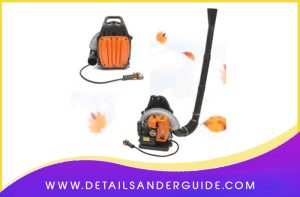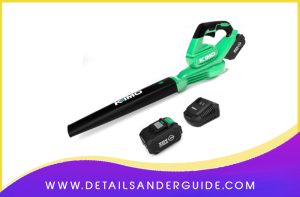What is a leaf blower

HYCHIKA Detail Sander, 14,000 OPM Compact Electric Sander Tool with 12 Pcs Sandpapers,Efficiency Dust Collection System,Suitable for Tight Spaces Sanding,Polishing,Removing Paint in Home Decoration
$28.95 (as of July 7, 2025 18:35 GMT +00:00 - More infoProduct prices and availability are accurate as of the date/time indicated and are subject to change. Any price and availability information displayed on [relevant Amazon Site(s), as applicable] at the time of purchase will apply to the purchase of this product.)Cordless Impact Driver for DeWalt 20V Max Battery, 2800 In-lbs Brushless 1/4" hex chuck Impact Driver, impact drill with 5-Speed Lightweight Power Impact Drivers, LED Light (no battery)
$59.99 (as of July 7, 2025 18:42 GMT +00:00 - More infoProduct prices and availability are accurate as of the date/time indicated and are subject to change. Any price and availability information displayed on [relevant Amazon Site(s), as applicable] at the time of purchase will apply to the purchase of this product.)Each leaf blower is a motor-driven device that is primarily used in the garden and generally outdoors. A leaf blower is designed to use an air stream to mobilize the fallen leaves, lawn, and hedge pruning as well as other garden waste. Some models combine three functions, namely leaf blowing, leaf vacuuming, and chopping. we introduce our readers to several monofunctional blowers as well as some 3-in-1 garden tools.
How is a leaf blower structured?
The heart of every leaf blower is a powerful motor, which can be an electric, battery, or gasoline drive. The motor drives a blower coupled to it, which generates an airflow. In the case of leaf blowers with suction function, the blower can also generate the negative pressure so that the air and with it the garden waste is sucked in.
The motor is housed in a plastic housing, which also includes the controls such as an on/off knob, a rotary knob for throttling the blowing speed, a starter for gasoline engines, and possibly a lever for switching between the blowing and suction function. A handle, often reinforced with rubberized, non-slip grip elements, is also integrated into the housing.
The blowpipe is connected to the motor housing, usually tool-free. This tube is usually slightly bent and narrow at the end to further accelerate the airflow. Most leaf blowers with suction function are supplied with two pipes – a blowpipe and with a suction pipe – and are equipped with a shredding wheel for crushing the waste. Some leaf blower/vacuum models, on the other hand, only have a multifunction tube.
Leaf Blower Test: A leaf blower with an electric drive is connected to the mains using a supplied power cable. A gasoline engine has a tank for the gasoline mixture, the volume of which is on average 350 – 500 ml. A cordless leaf blower is equipped with a device for connecting a compatible accumulator.
If it is a multi-function blower, a collection bag for holding the chopped leaf mass is included in the scope of delivery.
Which versions of leaf blowers are there?
Attention: The models available on the market differ in the range of functions. As already mentioned above, the pure leaf blowers are designed exclusively for blowing away fallen leaves, lawn clippings, etc., while the 3-in-1 devices also have a shredding and suction function.
The low weight and thus easy handling of the monofunctional leaf blowers prove to be advantageous. The multifunctional devices can be used in many ways in the garden and help not only to mobilize the garden waste but also to process it into recyclable compost or mulch. But such garden tools usually weigh well over 3 kg and are on average more expensive.
In addition, the leaf blowers differ according to their type of drive. we present several devices with gasoline, battery, and electric drive and explain below what advantages and disadvantages each version has for the user.

Pros
- Very high power consumption, powerful airflow
- Autonomous operation and long operating time approx. 60 min
- Ideal for spacious plots, can be used in any weather conditions
cons
- Less environmentally friendly compared to electric or cordless leaf blowers
- Sound emission is 100 dB(A)
What criteria should be taken into account when choosing a leaf blower?
Below we explain which functions a leaf vacuum cleaner is equipped with today and evaluate their relevance for the consumer. In this buying guide, we want to help you in this way with the purchase decision and put an end to the agony of choice.
- The first question to answer is the type of drive of the desired model. Above, we have already listed all the advantages and disadvantages of battery, electric, and gasoline leaf blowers. To put it in a nutshell: For smaller areas and smaller amounts of leaves, a leaf blower with an electric or battery drive is a good idea. For large plots of land, difficult terrain, and considerable work volume, a leaf blower with a combustion engine is recommended.
- Then it has to be decided whether you need a monofunctional device, i.e. only a leaf blower, or a multifunctional leaf blower with shredding and suction function. If you are only interested in clearing the fallen leaves out of the way and possibly forming piles of leaves, a pure leaf blower is recommended. If you want to crush the amounts of leaves and other garden waste compactly and also continue to use them as fertilizer, a 3-in-1 device is ideal.
- The weight of the garden tool plays a decisive role inconvenient handling: the lighter the leaf blower, the easier the handling. If you are specifically looking for a lightweight, a cordless or electric leaf vacuum cleaner is recommended. A leaf blower with a combustion engine, on the other hand, rarely weighs less than 4 kg and is, therefore, less handy.
- It is worth paying attention to the ergonomics of a leaf blower. In addition to the weight, the shape of the handles and the presence of a shoulder strap (carrying strap) are also important. A high-quality blower is equipped with a multi-adjustable and individually adaptable belt for back-friendly work as well as with a handle with rubberized, non-slip inserts.
- One of the most important parameters in the search for a leaf blower turns out to be the blowing speed. The airflow strength determines whether only dry, loose fallen leaves or fixed, rain-soaked garden waste, as well as branches and pine cones, can be mobilized. The blowing speeds below 250 km/h are recommended for minor clean-up work in the garden area and for largely dry foliage. Speeds from 300 km/h and more effectively remedy the disposal of various, including damp and stubborn garden waste.
- Do you value flexibility? Then look for a leaf blower with adjustable blow speed. you will always find some garden tools with this feature. Our tip: If the maximum airspeed does not exceed 250 km/h and the leaf blower is used exclusively in outdoor areas, you can easily do without a rotary knob to adjust the blowing speed.
- Especially for multifunctional leaf blowers, such criteria as the suction power in cubic meters per hour, the volume of the collection bag, and the strength of the shredding wheel also play a role. Learn to correctly assess these aspects with the help of our buying guide and product comparison on the subject of "leaf vacuums"!
You May Also Read:
When can a leaf blower be used?
A leaf blower is a motor-driven device and as such a source of the noise. The sound emission of a leaf blower ranges from 70 dB(A) for some battery and electric blowers to 110 dB(A) for petrol engines. All leaf blowers and leaf vacuum cleaners are subject to the Equipment and Machine Noise Protection Ordinance (32nd BImSchV). First and foremost, this regulates the operating times of these garden tools.
What should be considered when using and caring for a leaf blower?
What you should pay attention to basically, all leaf blowers belong to the low-maintenance machines and therefore require little care. For storing these garden tools, a dry, unheated shed is best. But even in a storage room or a cellar, these devices can be stored space-saving and safely.
Be sure to use flowing, circular movements to move the foliage in the desired direction without whirling it up. Use your leaf blower and vacuum cleaner only for the specified purpose, whether indoor or outdoor: These devices are primarily suitable for cleaning up and processing garden waste such as leaves, lawn clippings, pine cones, smaller branches, and for sweeping out workshops or workshops.
Read Related Product Reviews: 5 BEST RIDGID BELT SANDERS 2021
What is the opinion of conservationists on the leaf blower?
Nature conservation associations are still skeptical about these garden tools. The following four points of criticism or arguments against a leaf blower are usually brought:
- A leaf blower threatens the lives of countless small creatures, including many beneficial organisms that are disturbed or even killed by the airflow.
- Leaf-free plots offer hedgehogs and other useful animals no hiding place and no winter quarters. Therefore, we strongly recommend never removing all the foliage from a plot and using your leaf blower primarily to form several piles of leaves. The piles of leaves should be left standing over winter.
- The fallen leaves are not only annoying but also offer, for example, sensitive shrubs in winter reliable root protection. If you remove the foliage from the lawns, garden paths, driveways, etc., you are allowed to blow some of the leaves onto the beds. Last but not least, the roses benefit from this warming foliage coat.
- Leaf blowers are an intense source of noise and thus burden people and animals. In addition, models with combustion engines are not particularly environmentally friendly.
Can gravel beds and paths be cleaned with a leaf blower?
In principle, it is possible to free a bed filled with pebbles or a garden path from fallen leaves and smaller garden waste with the help of a leaf blower. The most important condition remains that the stones are not mobilized.
If you want to clean gravel beds and garden paths, we recommend choosing a leaf blower with an overall low blowing speed below 210 km/h or with variably adjustable airflow. A battery leaf blower is usually a good choice.
First, keep the blowpipe at a distance of about 5 cm from the gravel bed to test the effect of the airflow and possibly adjust the blowing thickness.
Can a leaf blower also be used indoors?
First and foremost, the leaf blowers are designed for outdoor use. However, in particular, a blower with a low or flexibly adjustable blowing speed may be used indoors. Among other things, wood chips in a workshop, dust from a computer case or borehole as well as cobwebs may be blown away from the ceiling with an air blower.
































